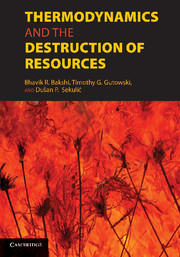Book contents
- Frontmatter
- Contents
- Contributor List
- Foreword by Herman E. Daly
- Foreword by Jan Szargut
- Preface
- Introduction
- PART I FOUNDATIONS
- PART II PRODUCTS AND PROCESSES
- 4 Materials Separation and Recycling
- 5 An Entropy-Based Metric for a Transformational Technology Development
- 6 Thermodynamic Analysis of Resources Used in Manufacturing Processes
- 7 Ultrapurity and Energy Use: Case Study of Semiconductor Manufacturing
- 8 Energy Resources and Use: The Present Situation, Possible Sustainable Paths to the Future, and the Thermodynamic Perspective
- PART III LIFE-CYCLE ASSESSMENTS AND METRICS
- PART IV ECONOMIC SYSTEMS, SOCIAL SYSTEMS, INDUSTRIAL SYSTEMS, AND ECOSYSTEMS
- Appendix: Standard Chemical Exergy
- Index
- References
6 - Thermodynamic Analysis of Resources Used in Manufacturing Processes
Published online by Cambridge University Press: 01 June 2011
- Frontmatter
- Contents
- Contributor List
- Foreword by Herman E. Daly
- Foreword by Jan Szargut
- Preface
- Introduction
- PART I FOUNDATIONS
- PART II PRODUCTS AND PROCESSES
- 4 Materials Separation and Recycling
- 5 An Entropy-Based Metric for a Transformational Technology Development
- 6 Thermodynamic Analysis of Resources Used in Manufacturing Processes
- 7 Ultrapurity and Energy Use: Case Study of Semiconductor Manufacturing
- 8 Energy Resources and Use: The Present Situation, Possible Sustainable Paths to the Future, and the Thermodynamic Perspective
- PART III LIFE-CYCLE ASSESSMENTS AND METRICS
- PART IV ECONOMIC SYSTEMS, SOCIAL SYSTEMS, INDUSTRIAL SYSTEMS, AND ECOSYSTEMS
- Appendix: Standard Chemical Exergy
- Index
- References
Summary
Introduction
The main purpose of manufacturing processes is to transform materials into useful products. In the course of these operations, energy resources are consumed and the usefulness of material resources is altered. Each of these effects can have significant consequences for the environment and for sustainable development, particularly when the processes are practiced on a very large scale. Thermodynamics is well suited to analyze the magnitude of these effects as well as the efficiency of the resource transformations. The framework developed here is based on the exergy analysis that is reviewed in the first two chapters of this book. Also see [1–5]. The data for this study draw on previous work in the area of manufacturing process characterization, but also includes numerous measurements and estimates we have conducted. In all, we analyze 26 different manufacturing processes, often in many different instances for each process. The key process studies from the literature are as follows: for microelectronics, Murphy et al. [6], Williams et al. [7], Krishnan et al. [8], Zhang et al. [9], and Boyd et al. [10]; for nanomaterials processing, Isaacs et al. [11] and Khanna et al. [12]; for other manufacturing processes, Morrow et al. [13], Boustead [14, 15], Munoz and Sheng [16], and Mattis et al. [17]. Some of our own work includes Dahmus and Gutowski [18], Dalquist and Gutowski [19], Thiriez and Gutowski [20, 21], Baniszewski [22], Kurd [23], Cho [24], Kordonowy [25], Jones [26], Branham et al. [27, 28], and Gutowski et al. [29].
- Type
- Chapter
- Information
- Thermodynamics and the Destruction of Resources , pp. 163 - 189Publisher: Cambridge University PressPrint publication year: 2011
References
- 10
- Cited by



